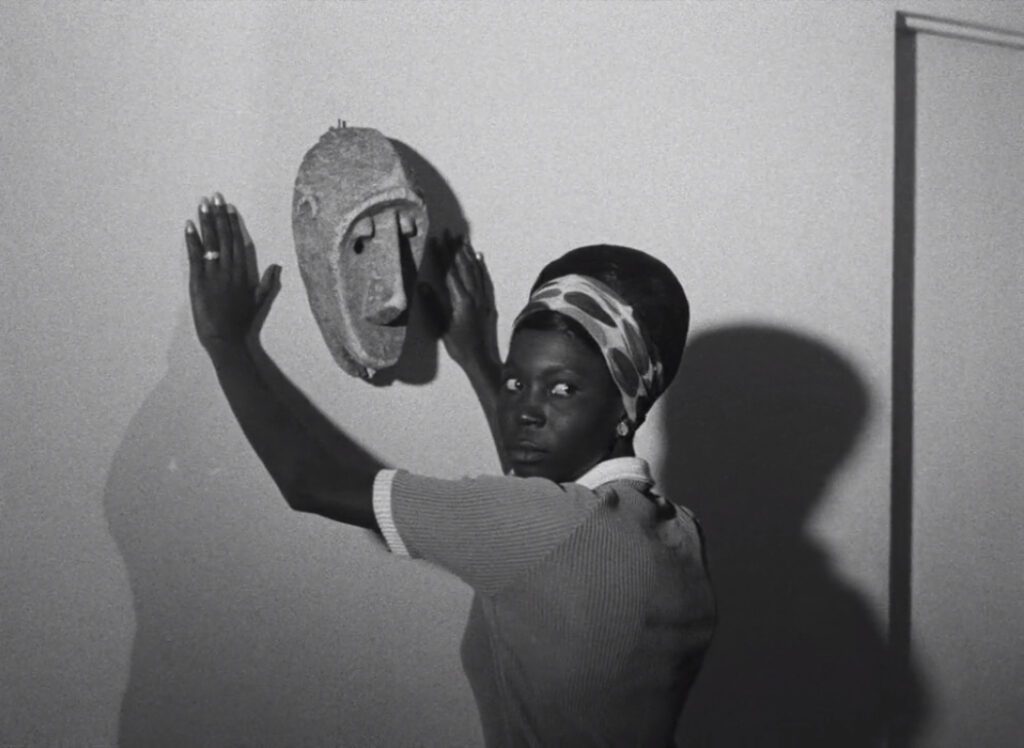
Black Girl
1966, directed by Ousmane Sembène
The African mask that follows the characters through Black Girl goes through so many contexts, with so many different emotional flavors, that it’s almost a character in its own right. When it first appears, hung prominently in the Antibes apartment where Diouana will perform her chores, it looks like an exotic object, a piece of African culture displaced to the French Riviera. When Diouana first borrows it during a flashback to celebrate her employment in Dakar, it’s a festive object, closer to its original purpose. When she gives it to her employers as a token of gratitude, it’s a stand-in for Diouana, giving herself to the French family who will soon abuse her trust. When she reclaims the mask she reclaims not her life but her dignity, as she will give up her life on the same day.
A mask is an almost universal sign of identity. In a theater or a ceremony it confers a particular identity on its wearer, or it can be used to hide the wearer’s original identity. It’s therefore easy to guess that this wooden mask points to Diouana’s identity, or possibly to her lack of identity in the eyes of her French employers. Nevertheless, with the variety of roles this mask plays, its precise relationship to Diouana remains vague. Until the end when the little boy lowers it to show his face, it’s an open question how exactly we should read the mask.
When the Senegalese boy follows Monsieur from Diouana’s neighborhood to his car, we finally see this object separate from Diouana. Whatever the mask may have meant in her hands, or on the wall in Antibes, this final shot broadens its meaning while simultaneously defining it more precisely.
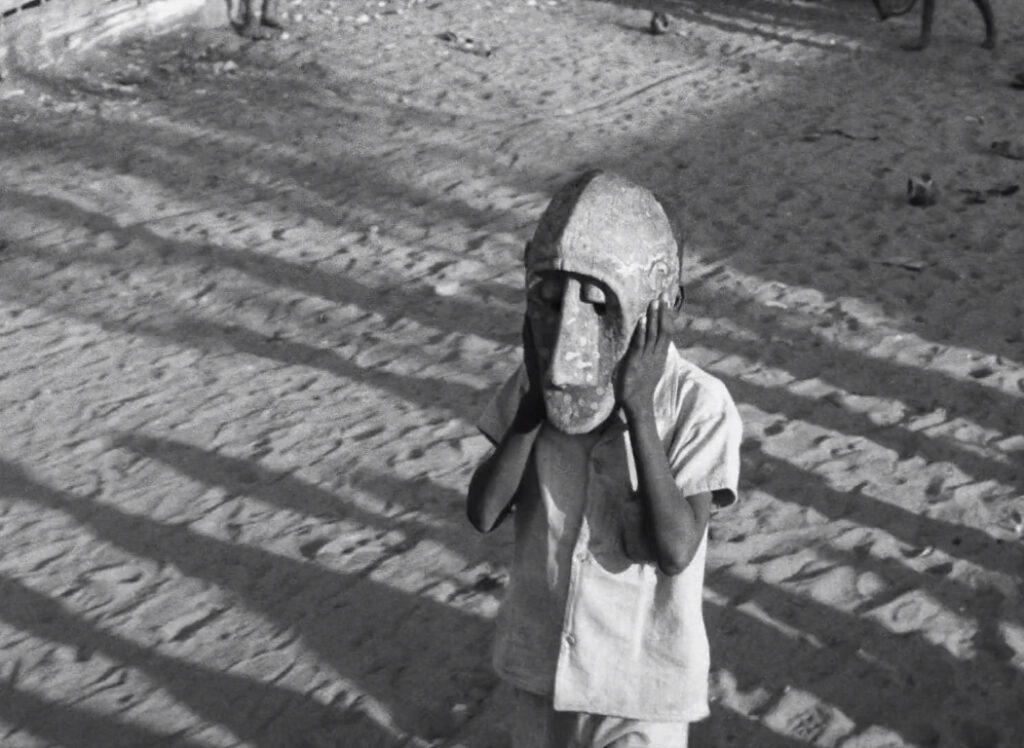
The last scene of Black Girl is full of irony, always a signal to look at things anew. When Monsieur leaves Diouana’s mother the plot is effectively over, yet ironically one of the most dramatic scenes is yet to come. After an hour of internal monologues and everyday household tasks, we finally have a chase scene. It’s also ironic that Monsieur, who was not afraid to show up at Diouana’s home after she killed herself in his custody, and who was not afraid of the stares of the grown men by the schoolhouse, is so unnerved by the small child who follows him to his car. He turns to look back at his masked pursuer ten times, and he quickens his gait. If it’s not the boy who frightens him but rather the mask, that too would be ironic because it’s the same mask that hung for weeks in his own dining room. But the greatest irony comes at the end when the boy stops and lowers the mask.
Many things are going on in this final gesture. First of all, as the boy watches Monsieur drive away his eyes shift back and forth, ironically revealing an impressionable child who’s nothing like the avenging angel that Monsieur must have imagined. Secondly, for most of the shot the boy faces the camera, as if inviting the audience to see in him what we hadn’t seen before. Thirdly, it’s important that the mask has passed from the protagonist, Diouana, to this anonymous boy who originally sold it to her. It no longer stands for Diouana alone, but for millions of Africans whose identity has been altered by colonialism.
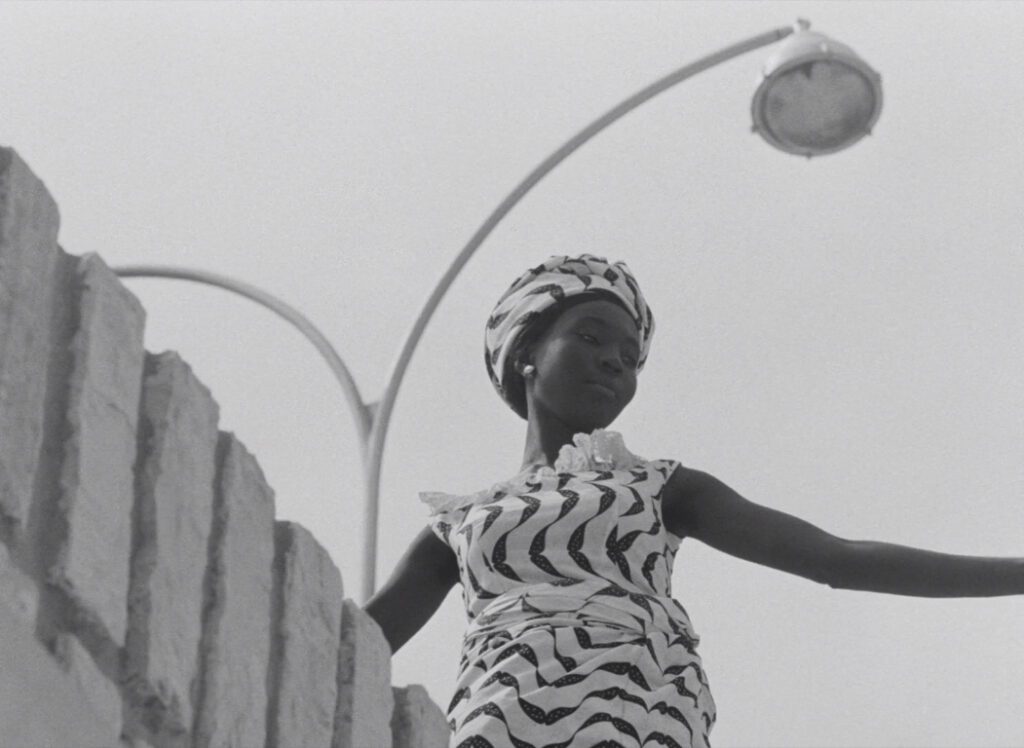
Numerous details in Black Girl hint that Diouana’s story represents a broader history of African suffering under European oppression. She describes her situation as “slavery”; her employers come from the same country that had colonized her own; she visits the Plaza of Independence in Dakar where a flashback within the flashback shows dignitaries laying flowers at the war memorial; and a tapestry commemorating pan-Africanist leader Patrice Lumumba hangs on Diouana’s boyfriend’s wall. It’s ironic that six years after Senegal’s independence the same exploitative relationship would continue, as if independence had never actually occurred.
Everything the white French characters say and do corresponds readily to the actions of an imperial nation. Like a colonial power imposing its laws and degrading its subjects, Madame yells at Diouana and makes her dress down to a lower status. In the mold of so many imperialists, Madame and Monsieur put words in Diouana’s mouth, telling guests how angry she must feel and composing a letter to her mother in her name. Like the empires who controlled Africans through slavery, apartheid, exploitative labor, and arbitrary borders, they restrict her to the apartment, patronizingly claiming to be “responsible” for her. Madame calls her “lazy” and yells that “We’re not in Africa!” One of their guests says condescendingly that “Their independence has made them less natural,” and another kisses Diouana on the cheek for the novelty of kissing a black woman, thus dehumanizing her. They appreciate African art and cooking, and they treat Dakar as a second home, but they never treat an African person as an equal. It’s no wonder that halfway through the film Diouana looks out her window at night and describes France as a “black hole”. In yet another irony, Europe has become the “dark continent” in her eyes.
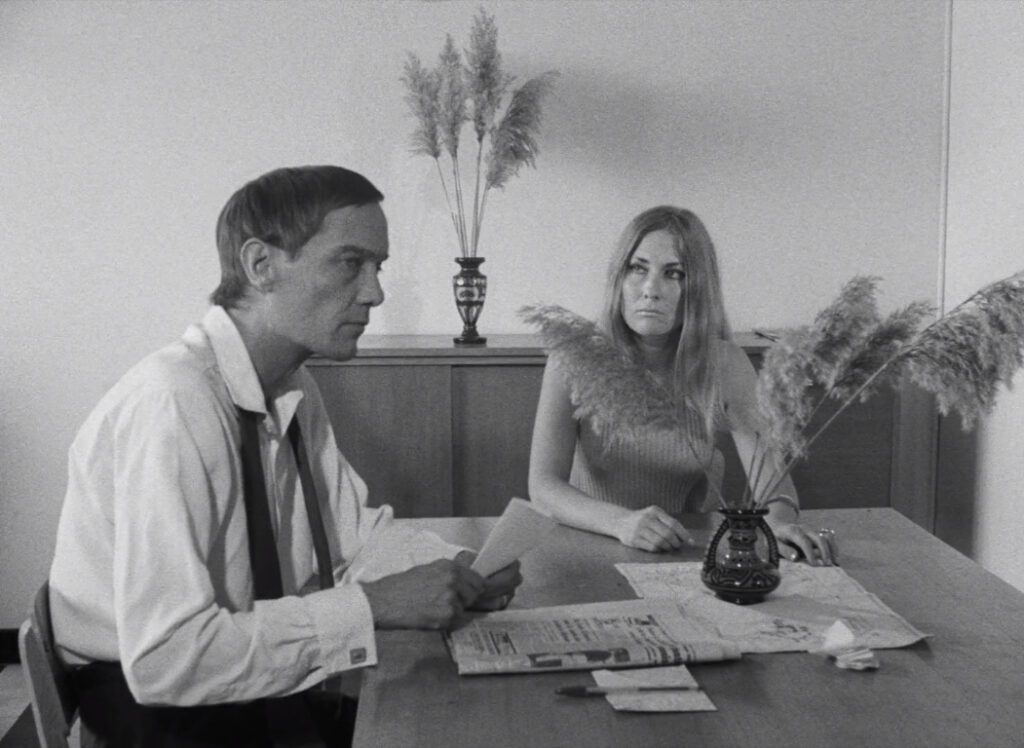
The difference between Africa and Europe is reinforced in a further irony, that someone who loves life as much as Diouana would be reduced to suicide in Antibes. In Senegal we see her full of dreams and ambitions as she looks for a job and dreams of seeing France. When she finds work with “les blancs” she overflows with enthusiasm, but in Europe her existence becomes a living death.
The personal story of Diouana and the almost allegorical commentary on colonial oppression are not competing interpretations in Black Girl. The history of imperialism is an accumulation of smaller stories like Diouana’s, and it’s not remarkable that the microcosm and macrocosm should mirror each other. What is remarkable is that after centuries of coexistence there should still be such a gulf between the two cultures. This gulf is materialized in the bridges everyone must cross to reach the other’s world. When Diouana arrives in Marseille the movie takes care to show a crane lifting a bridge to connect the ship to the dock, and likewise when Monsieur comes to Diouana’s home (or whenever Diouana crosses from the Europeanized part of Dakar) there’s a long footbridge. Prominent contrasts between black and white allude to the same gulf – contrasts between skin color and clothing, the bold black and white stripes on the apartment floor, the coffee and milk, the bright white buildings with dark windows.
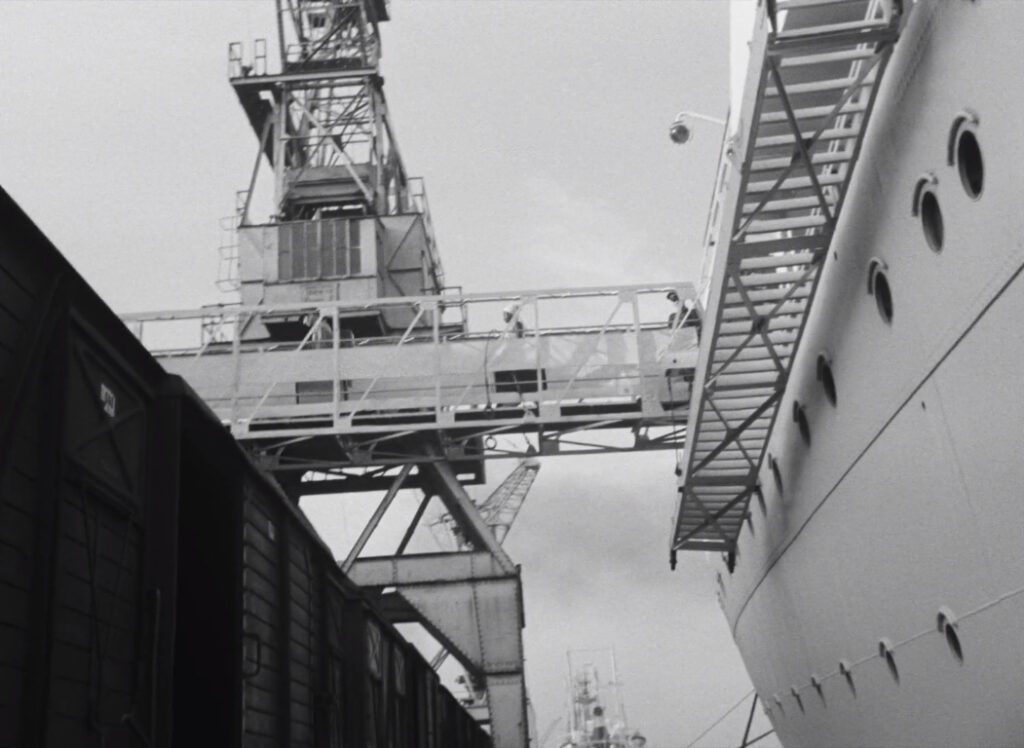
Surely one of the bitterest ironies is that the record of Diouana’s work in Antibes starts with scrubbing the bathtub where she will later die, as if she had come to France just to prepare her own coffin. The bathtub neatly brackets her period of servitude, whose musical theme (one of four in Black Girl) begins and ends around those two key bathtub scenes – her first chore and her suicide. The bathtub appears a third time near the end when Madame retrieves Diouana’s robe and looks at the freshly cleaned white tub. There’s a dual insinuation here – with Diouana’s blood washed away Madame is ready to forget her own guilt, and her apartment is ready for the next cycle of exploitation.
The root of the problem surfaces in an exchange about Diouana at the lunch gathering: “Does she speak French?” “No.” “But she understands.” “Instinctively?” “Yes, I suppose so.” “Like an animal.” The only words we ever hear her speak to her employers, apart from the likes of “Oui, Monsieur” and “Non, Madame”, are when she says the mask belongs to her. However her thoughts are expressed in fluent French, and she speaks French with her boyfriend in Senegal. Whether her silence toward her employers is literal or figurative does not matter – what’s important is that they absolutely fail to notice that she speaks French. Their obtuseness is only part of a broader pattern of failing to see or hear Africans. Despite years of close proximity in both Europe and Africa, these white people seem entirely unaware both of Africans’ humanity and of their suffering.
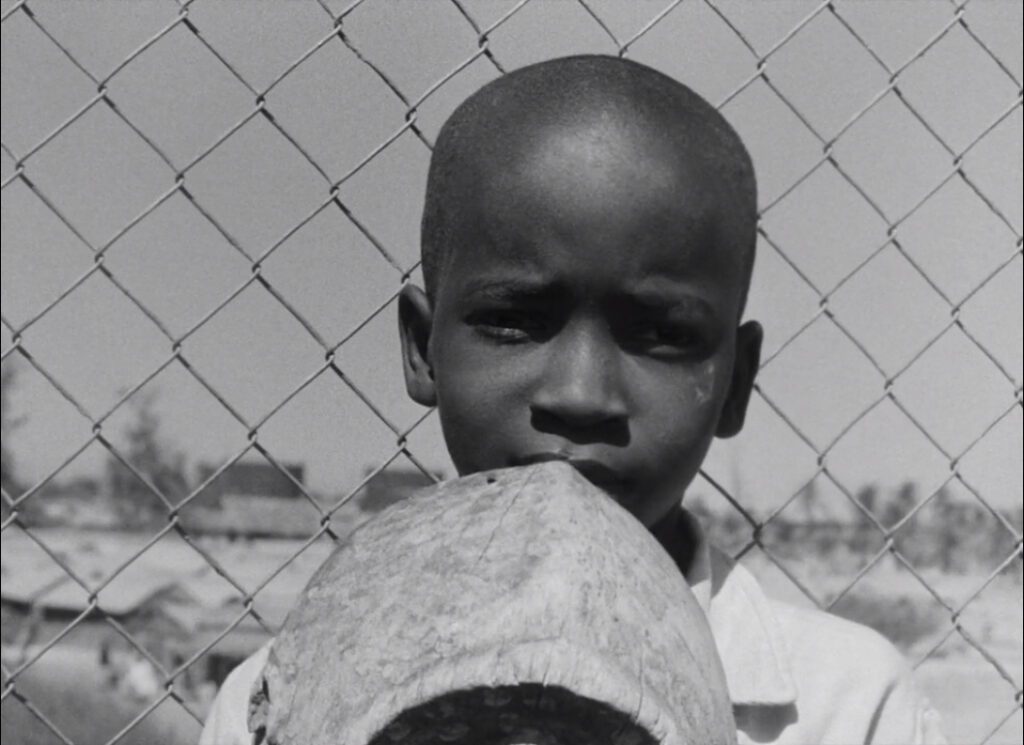
With this in mind, the final scene – and the purpose of the mask all along – should become clear. When the young boy lowers the mask, Monsieur is already driving away and cannot see him. However if we’ve paid attention we can see what Monsieur refuses to see – that behind this mask is the face of a whole continent’s invisible pain.
CONNECTIONS:
Shadow of a Doubt – Symbolic object (ring/mask) confers power/agency/control on its holder
Blow-Up – Multiple layers of irony pointing to a new way of seeing
Bye Bye Africa – Camera & mask parallels; boy follows man to car at end holding mask/camera; scene of struggle over mask/camera; young woman’s suicide; Africans living in France
Caché – Allegory for relations between France and its African colonies; white guilt and fear of the “other”